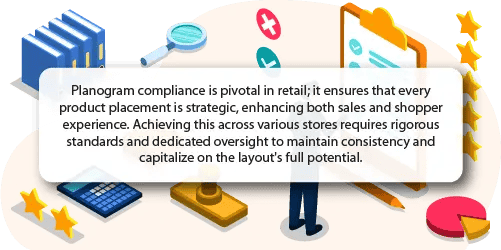Planogram compliance is pivotal for retailers aiming to harmonize store aesthetics and maximize sales, yet achieving it across multiple locations poses significant challenges. From varying store layouts to regional consumer preferences, ensuring uniformity while accommodating local differences is essential. Addressing these complexities enhances brand integrity and optimizes the shopping experience.

Effective planograms cater to broad market trends and nuanced consumer preferences, directly influencing purchasing behavior. When stores consistently reflect these tailored layouts, they boost sales while building customer trust and satisfaction. Maintaining rigorous planogram compliance is thus crucial for optimizing inventory management and enhancing the overall shopping experience.
Addressing these challenges means retailers must integrate planograms, which respond to market dynamics and individual store characteristics. It involves leveraging advanced technologies for real-time monitoring and feedback. It also means establishing structured processes that ensure each location adheres to corporate standards while reflecting local consumer demands. All of this leads to an optimized retail strategy and operational efficiency.

Challenge: Implementing planograms across different store configurations
One size does not fit all. That's especially true when it comes to physical retail store layouts. It's why a common compliance challenge lies in implementing standardized planograms across various store configurations.
For example, a large department store chain might have vast flagship stores in major cities with ample floor space alongside smaller boutique-style locations in suburban malls. Each store may have different ceiling heights, column placements, or existing fixtures, complicating the uniform application of a single planogram.
The discrepancies between each store layout can lead to inefficiencies such as product overcrowding in smaller stores or underutilized spaces in larger ones, negatively impacting the customer shopping experience and potential sales.
For example, a planogram designed for a spacious urban store might place high-demand items in prominent central locations. However, the same arrangement might not be possible in a narrower, column-heavy layout of a smaller store, leading to missed sales opportunities.
Solution: Modular planogram components
Adopting modular planogram components provides a versatile solution to such a challenge. Modular design involves creating planogram elements that can be easily adjusted or reconfigured to fit different spaces without losing the integrity of the overall visual merchandising strategy.
This flexibility allows retailers to adapt layouts to accommodate local store features while maintaining consistency in product presentation.
Prevention: Leverage specialist software tools
In most cases, prevention is better than a cure, and it’s the same for retail. Investing in specialist software tools that can generate customized planograms based on specific store dimensions and features is an effective preventive strategy. DotActiv is one such example.
DotActiv software enables retailers and suppliers to optimize their product placement, ensuring that the planogram is practical and effective in maximizing sales and enhancing the customer experience.
For example, retailers like Food Lover's Market and Makro use DotActiv software, which includes features built specifically for creating and modifying planograms based on precise store layouts. The software also boasts features that suggest the best placement of products on a shelf based on sales data.
By adopting such tools, retailers can ensure that each store, no matter the location, operates at maximum efficiency while maintaining its brand identity and customer experience.
 Challenge: Adapting to regional consumer preferences
Challenge: Adapting to regional consumer preferences
Retailers that operate across different geographic locations encounter a diverse array of consumer preferences and behaviors, which can complicate the application of a one-size-fits-all planogram.
Consumer preferences vary significantly between urban and rural areas or different cultural regions.
For example, a product that sells well in a cosmopolitan city like New York may see a different success in more rural areas, where consumer needs and lifestyles differ.
This variability can lead to inefficiencies when using a standardized planogram.
That means a retailer may find bulk goods more popular in suburban and rural areas where consumers have more storage space, whereas urban dwellers prefer smaller, more frequent purchases due to space constraints.
Solution: Establish a feedback loop from store managers
One effective solution to this challenge is establishing a feedback loop that involves store managers communicating regularly with the central planning team. It allows the integration of real-time, ground-level insights into planogram adjustments, ensuring displays are responsive to local consumer preferences.
For example, a retailer might implement technology-focused planograms in areas with a higher concentration of tech-savvy consumers based on feedback from local managers about trending consumer electronics.
Conversely, in regions where consumers prioritize different types of products, planograms can be adjusted to focus more on those items, ensuring that the product mix and presentation align with local demands.
Prevention: Use advanced data analytics
Addressing these regional disparities means retailers must be proactive. One such action is to use advanced data analytics to predict and plan for regional trends. This approach involves analyzing datasets to discern buying patterns and preferences unique to specific areas, which can inform more targeted planogram designs.
For example, Food Lover's Market uses DotActiv software, which includes built-in data analysis capabilities that help track and analyze purchasing trends across different regions. Analyzing such data helps them anticipate regional demands and seasonal shifts, allowing them to tailor their inventory and presentation to local markets before deploying new planograms.
Retailers can use these features not only for product assortment and planogram compliance but also as a foundation to inform marketing and promotional strategies for regional audiences, enhancing customer satisfaction and store performance.
By integrating local store feedback into planogram adjustments and employing data analytics, retailers can ensure their displays resonate with regional audiences, which allows them to optimize their market reach and effectiveness.

Challenge: Balancing corporate standards with store autonomy
Another common planogram compliance challenge lies in maintaining a uniform brand image while adapting to the unique characteristics of local markets.
The tension arises because corporate-designed planograms, which aim to standardize the presentation and optimize customer experience, might not align perfectly with local consumer behaviors or store-specific constraints.
For example, a global retailer must ensure its stores reflect its iconic look and feel, yet each location might serve a slightly different demographic. Urban stores may thrive with a layout accommodating quick, grab-and-go traffic, whereas suburban locations might benefit from layouts encouraging shoppers to stay in-store longer.
Solution: Have structured communication channels
Managing this balance means establishing structured communication channels where store managers can provide feedback and suggest modifications to the head office. This system ensures that local insights are heard and integrated into the broader corporate strategy, enhancing relevance and performance.
How would that look in practice? It would be at a retailer that allows its store managers to have a say in modifying planograms to fit their customer base and local demand. That includes adjusting the stock and display of seasonal products.
Communicating these adjustments through a centralized system ensures that any changes align with the overall brand standards.
Prevention: Regular training and updates
Preventing conflicts and ensuring a smooth integration of local adaptations require ongoing training and regular updates for store managers. This initiative helps them understand the broader corporate goals and how to implement them without detracting from the overall core values of the brand.
For example, a retailer can operate franchise training programs that cover the basics of operation and emphasize the importance of maintaining brand consistency while allowing for local adaptations in their product offering.
Regular workshops can keep managers updated on new company policies, merchandising strategies, and product information, ensuring alignment across all locations. If a retailer doesn't have the in-house knowledge, they can outsource it to third-party experts.
Retailers who leverage regular training sessions can ensure that while each store has the autonomy to cater to local market trends, overarching customer service standards and store aesthetics remain consistent.
Fostering open communication, providing strategic autonomy, and offering continuous training means retailers can balance corporate consistency with local relevance. This approach enhances customer satisfaction across diverse markets and strengthens overall brand integrity.

Challenge: Logistical complexities in planogram compliance monitoring
Monitoring and ensuring compliance with planograms across numerous locations presents significant logistical challenges. Ensuring that every store adheres to the prescribed layouts and product placements is crucial for maintaining brand integrity and operational efficiency.
However, the geographic spread and number of stores can complicate oversight.
For example, a multinational retailer with thousands of stores worldwide faces the daunting task of routinely checking each store’s alignment with company standards.
Solution: Technology integration for compliance monitoring
To overcome this challenge, integrating advanced technologies such as digital imaging and AI can revolutionize how retailers ensure planogram compliance.
Digital imaging technology allows retailers to capture store layouts in real-time, which can be analyzed using AI to detect deviations from the approved planograms. This technology speeds up the monitoring process and increases accuracy, reducing reliance on manual checks.
For example, retailers can use digital imaging and AI to monitor shelf stock and compliance. Cameras capture images of the shelves, and AI algorithms analyze these images to verify that items are correctly stocked and displayed according to the planogram. This system allows for rapid corrections and ensures consistency across all locations.
Prevention: Set up internal audit systems
An essential preventative measure is setting up a more comprehensive internal audit system that conducts random and regular checks. This approach ensures continuous adherence to planogram specifications and allows retailers to identify and rectify non-compliance issues before they impact sales or customer experience.
A retailer can employ such an audit system, where internal teams routinely visit stores to ensure that all departments comply with the national standards associated with product displays and shelf placement. These audits help retailers to gather insights into why certain deviations occur, whether due to oversight or deliberate implementation, and can guide further training or adjustments in planogram designs.
Ensuring planogram compliance through advanced technological tools and robust auditing processes is vital for maintaining operational consistency and maximizing sales. These strategies help detect and correct non-compliance quickly and provide data-driven insights that can lead to more effective and adaptable planogram strategies in the future.
Conclusion
Effective planogram compliance allows retailers to meet customer preferences and create a seamless shopping experience that drives efficiency and sales. Do you need specialist software that can help you achieve that? Discover the impact of optimized retail strategies with a free 14-day trial of DotActiv Enterprise.


